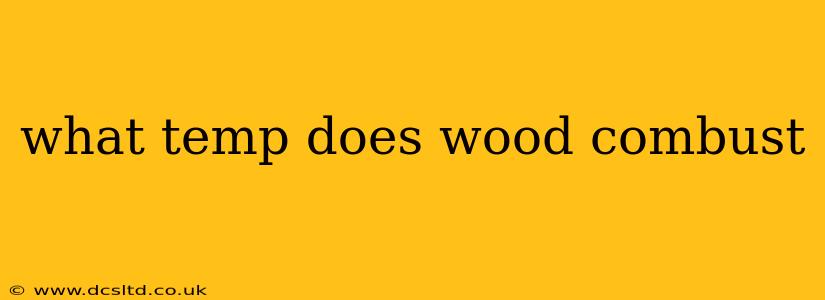The temperature at which wood combusts isn't a single, definitive number. Instead, it's a range influenced by several factors, making a precise answer complex. However, we can break down the process and explore the key variables.
The Process of Wood Combustion
Before wood bursts into flames, it undergoes a series of stages:
-
Preheating: As wood is exposed to heat, its moisture content begins to evaporate. This stage is crucial because the presence of moisture inhibits ignition. The drier the wood, the lower the ignition temperature.
-
Pyrolysis: Once the wood's surface temperature reaches around 200-300°C (392-572°F), pyrolysis occurs. This is a chemical decomposition process where the wood breaks down into volatile gases (like methane, methanol, and other hydrocarbons), tar, and charcoal.
-
Ignition: These volatile gases released during pyrolysis are flammable. When they reach their ignition temperature (which varies depending on the gas composition and concentration but is generally in the range of 250-400°C or 482-752°F) in the presence of sufficient oxygen, they ignite, producing flames. The charcoal itself may also begin to glow.
-
Combustion: The sustained burning of the wood occurs as the pyrolysis and ignition processes continue. The flame’s heat continues to drive further pyrolysis and maintain the chain reaction.
What Factors Influence Wood's Ignition Temperature?
Several factors affect the precise temperature at which wood will combust:
-
Wood Species: Different wood species have varying densities, moisture contents, and chemical compositions. Hardwoods generally have a higher ignition temperature than softwoods due to their higher density and lower moisture content.
-
Moisture Content: Wet wood requires significantly more heat to reach the ignition point. The water in the wood absorbs heat energy, delaying the pyrolysis process. Dry wood ignites much more easily.
-
Wood Size and Shape: Smaller pieces of wood with a larger surface area ignite faster than larger, denser pieces. This is because the heat transfer is more efficient in smaller pieces.
-
Oxygen Supply: Adequate oxygen is essential for combustion. Insufficient oxygen will lead to smoldering rather than flaming combustion.
-
Presence of other materials: The presence of other flammable materials can alter the ignition temperature. For instance, adding kindling (small, easily combustible materials) lowers the overall ignition temperature of the wood.
What is the typical ignition temperature range for wood?
While there's no single number, a reasonable estimate for the ignition temperature of dry wood is in the range of 250-300°C (482-572°F). However, remember that this is a simplified representation. Wet wood will require a much higher temperature.
How does this relate to wildfires?
Understanding wood's combustion temperature is crucial for wildfire prevention and control. Dry conditions, abundant fuel (wood), and high ambient temperatures create the ideal circumstances for rapid wildfire spread. Understanding the process helps in developing effective fire management strategies.
What is the difference between the flash point and ignition temperature of wood?
The flash point and autoignition temperature are different. The flash point is the lowest temperature at which a liquid produces enough flammable vapor to ignite momentarily when an ignition source is present. Wood is a solid, not a liquid, so this doesn't directly apply. The autoignition temperature is the lowest temperature at which a material will spontaneously ignite in normal atmospheric conditions without any external ignition source. While this is a concept related to wood's combustion, it is more complicated to define for a solid like wood than it is for a liquid.
This comprehensive overview should provide a clearer understanding of the complex process of wood combustion and the factors influencing its ignition temperature. Remember that safety precautions should always be observed when working with fire and combustible materials.
